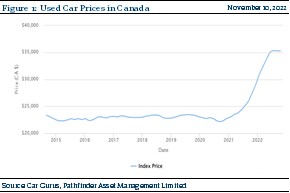The Used Car Phenomenon
We’ve all heard the saying “a car loses 30% of its value when you drive it off the lot”. The saying has lasted the test of time because the depreciation of a car has been as reliable as the tactics used car salesmen will use to try selling it. This week, we spotlight a highly unusual event: the drastic recent appreciation in used car prices. As can be seen in Figure 1, used car prices appreciated ~60% from September 2020 to July 2022. Let’s see how this occurred.
- The inability to make new cars: Car manufacturers have been producing far fewer cars. This is due to a series of shortages but none greater than the shortage in auto-specific semiconductor chips. During the pandemic, chip manufactures re-routed chip manufacturing capacity away from auto-related chips and towards more digitally intensive chips (data centers, computers, video games etc.). So, when the auto manufacturers wanted to restart new car production, they couldn’t purchase the amount of chips they previously had access too. This continues to restrict new car production.

- A spike in demand for vehicles: Since consumers typically borrow (or lease) money to buy cars, interest rates have an outsized impact on car demand. During the pandemic, central bankers lowered interest rates to 0% which naturally boosted demand for all assets consumers borrow money to own. Enhancing that, we’ve seen evidence that health concerns deterred individuals from public transit (where there are crowds) and towards owning their own vehicle. Combined, we observed a COVID-driven spike in auto demand.
When you have a spike in demand for an asset that can’t be produced, existing versions of that asset will see appreciation in price/value. This is what we observed for used cars from late-2020 to mid-2022. Moving forward, it may be prudent to expect used vehicles to resume their “normal” depreciation schedule as higher interest rates cool demand and new auto chip manufacturing capacity is eventually added. Although, the latter is taking quite some time.
“This means that” a car lease comes with the embedded option to purchase the vehicle at a fixed price. We recommend clients (who have car leases approaching expiry) compare that fixed price to what they could sell that car for today, and don’t ask the dealership, check Autotrader. We suspect you might like what you see.
National Instrument 31-103 requires registered firms to disclose information that a reasonable investor would expect to know, including any material conflicts with the firm or its representatives. Doug Johnson and/or Pathfinder Asset Management Limited are an insider of companies periodically mentioned in this report. Please visit www.paml.ca for full disclosures.
*All returns are time weighted and net of investment management fees. Returns from the Pathfinder Partners’ Fund and Partners’ Real Return Plus Fund are presented based on the masters series of each fund. The Pathfinder Core: Equity Portfolio and The Pathfinder Core: High Income Portfolio are live accounts. These are actual accounts owned by the Pathfinder Chairman (Equity) and client (High Income) which contain no legacy positions, cash flows or other Pathfinder investment mandates or products. Monthly inception dates for each fund and portfolio are as follows: Pathfinder Core: Equity Portfolio (January 2011), Pathfinder Core: High Income Portfolio (October 2012) Partners’ Fund (April 2011), Partners’ Real Return Plus Fund (April, 2013), and Partners’ Core Plus Fund (November 2014).
Pathfinder Asset Management Limited (PAML) and its affiliates may collectively beneficially own in excess of 10% of one or more classes of the issued and outstanding equity securities mentioned in this newsletter. This publication is intended only to convey information. It is not to be construed as an investment guide or as an offer or solicitation of an offer to buy or sell any of the securities mentioned in it. The author has taken all usual and reasonable precautions to determine that the information contained in this publication has been obtained from sources believed to be reliable and that the procedures used to summarize and analyze such information are based on approved practices and principles in the investment industry. However, the market forces underlying investment value are subject to sudden and dramatic changes and data availability varies from one moment to the next. Consequently, neither the author nor PAML can make any warranty as to the accuracy or completeness of information, analysis or views contained in this publication or their usefulness or suitability in any particular circumstance. You should not undertake any investment or portfolio assessment or other transaction on the basis of this publication, but should first consult your portfolio manager, who can assess all relevant particulars of any proposed investment or transaction. PAML and the author accept no liability of any kind whatsoever or any damages or losses incurred by you as a result of reliance upon or use of this publication.